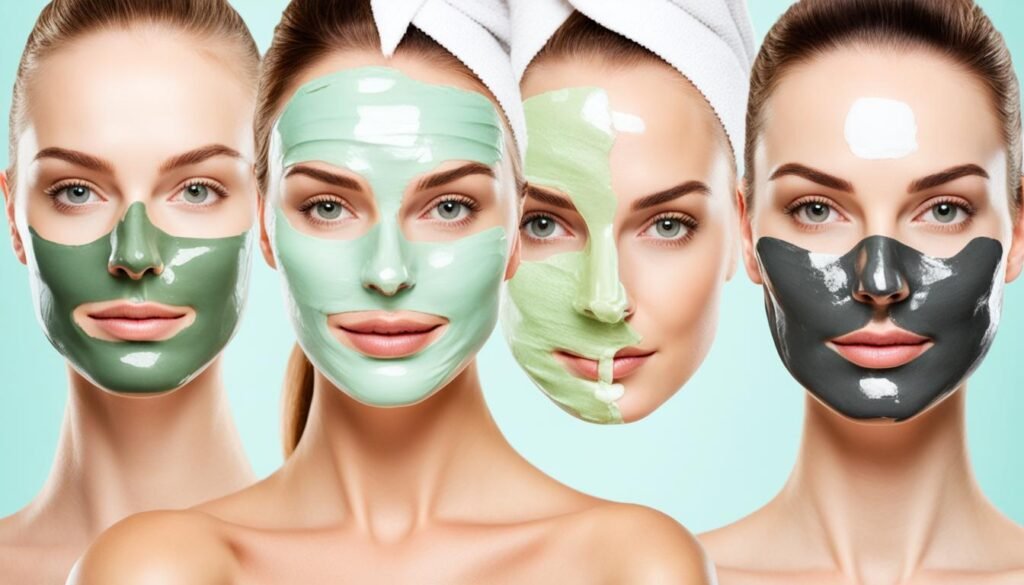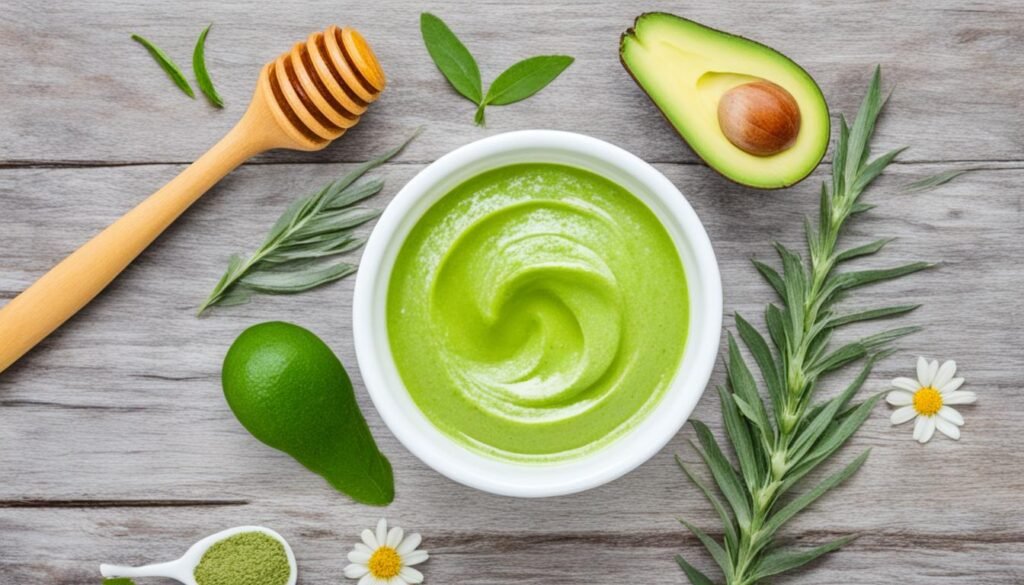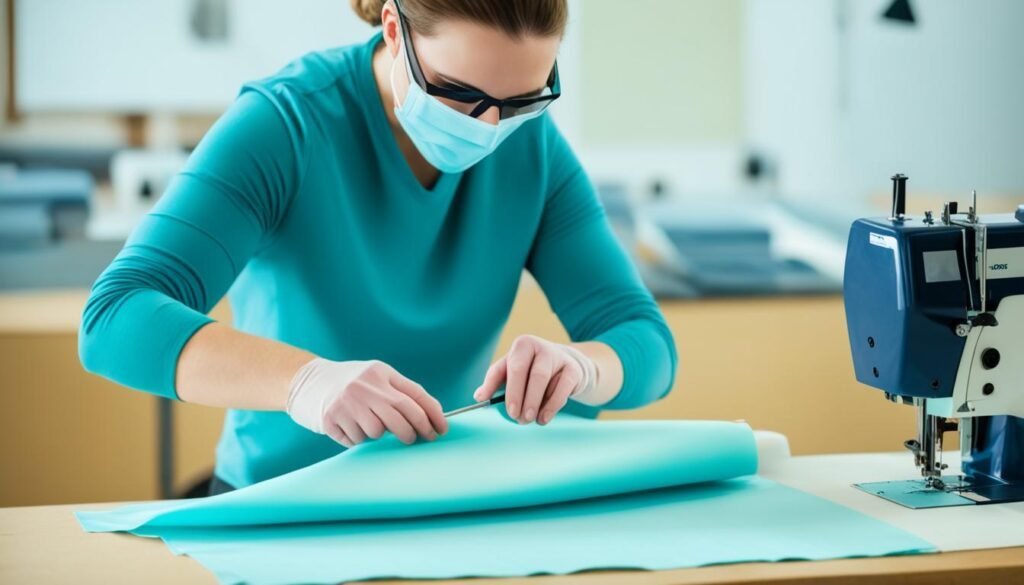During the pandemic, many of us have turned to self-care rituals and homemade beauty products to nurture our skin. And what better way to do that than with a DIY face mask? But with so many recipes and ingredients out there, how do you know which ones are safe and effective? Stick with us as we guide you through the world of homemade skincare and show you how to make a DIY face mask that suits your needs.
Whether you’re a skincare enthusiast looking to try something new or a beginner exploring the world of DIY beauty, this article is for you. We’ll cover everything from the benefits of homemade face masks to simple recipes for different skin concerns. Get ready to indulge in a little self-care and discover the wonders of natural ingredients for your skin.
Key Takeaways:
- Creating your own face mask allows you to utilize natural ingredients found in your kitchen.
- Homemade face masks can be a part of your self-care routine, providing relaxation and nourishment for your skin.
- There are numerous DIY face mask recipes for glowing skin, hydration, soothing, and targeted skincare concerns.
- Different skin types can benefit from tailored DIY face mask recipes designed to address specific needs.
- When using DIY face masks, it’s essential to prioritize your skin’s health and safety by being aware of potential sensitivities and avoiding harsh ingredients.
The Benefits of Homemade Face Masks
Homemade face masks offer a myriad of benefits for your skin, making them a popular choice for self-care enthusiasts. By using natural ingredients that are easily accessible from your kitchen, you can create personalized skincare treatments that cater to your specific needs. Let’s explore the advantages of incorporating homemade face masks into your skincare routine.
1. Natural Ingredients
One of the major benefits of homemade face masks is the ability to harness the power of natural ingredients. Unlike commercial skincare products that may contain harsh chemicals or synthetic additives, homemade masks allow you to use organic ingredients that are gentle and beneficial for your skin. From oatmeal and honey to avocado and green tea, these natural ingredients provide nourishment and hydration, helping to revitalize your skin.
2. Self-Care Ritual
Creating and applying a homemade face mask can be a wonderful way to practice self-care. Taking the time to pamper yourself and indulge in a skincare routine can promote relaxation, reduce stress, and boost your overall well-being. By incorporating homemade face masks into your self-care rituals, you not only improve the health of your skin but also enhance your mental and emotional state.
3. Personalized Skincare
Making your own face mask gives you full control over the ingredients that come into contact with your skin. Everyone’s skin is unique, and by customizing your mask, you can address specific concerns and tailor the treatment to your individual needs. Whether you have oily, dry, or sensitive skin, homemade face masks allow you to design a skincare routine that suits you perfectly.
So why not embrace the benefits of homemade face masks and treat your skin to a nourishing and rejuvenating experience? With natural ingredients, a touch of self-care, and a personalized skincare routine, you’ll be on your way to achieving a radiant complexion!
| Benefits of Homemade Face Masks |
|---|
| Natural ingredients |
| Self-care ritual |
| Personalized skincare |
Simple DIY Face Mask Recipes
Creating your own DIY face masks is a fun and cost-effective way to achieve glowing skin using natural ingredients. Whether you’re looking to hydrate, brighten, or soothe your skin, there are plenty of easy-to-make recipes that can cater to your specific needs. Take a look at some of these simple and effective DIY face mask recipes:
Turmeric Face Mask
Glowing Skin Recipe
In a small bowl, mix together 1 teaspoon of turmeric powder, 1 tablespoon of honey, and 1 tablespoon of plain yogurt. Apply the mixture evenly to your face and leave it on for 10-15 minutes. Rinse off with warm water and pat dry for a natural glow.
Honey Face Mask
Hydrating Recipe
Combine 1 tablespoon of honey with 1 tablespoon of coconut oil in a bowl. Gently massage the mixture onto your face and let it sit for 15-20 minutes. Rinse off with lukewarm water to reveal moisturized and nourished skin.
Hydrating Avocado Face Mask
Soothing Recipe
Mash half an avocado in a bowl and mix it with 1 tablespoon of honey and 1 tablespoon of plain yogurt. Apply the mask to your face and let it sit for 20 minutes. Rinse off with cool water to calm and hydrate your skin.
Peel-Off Face Mask
Deep Cleansing Recipe
In a small bowl, combine 1 tablespoon of activated charcoal powder and 1 tablespoon of organic gelatin. Add 2 tablespoons of warm water and mix it well until it forms a paste. Apply an even layer to your face, let it dry for 15 minutes, and peel it off gently for a refreshed and purified complexion.
Juice Cleansing Mask
Brightening Recipe
In a blender, blend together 1 tablespoon of cucumber juice, 1 tablespoon of tomato juice, and 1 tablespoon of lemon juice. Apply the mixture to your face using a cotton pad or your fingertips. Let it sit for 15-20 minutes before rinsing off with cool water to reveal a brighter and more rejuvenated skin tone.
Try these simple DIY face mask recipes for a natural and effective skincare routine. Remember to do a patch test before applying any new ingredient to your face and enjoy the benefits of homemade skincare.
DIY Face Masks for Specific Skin Concerns
Different DIY face masks can address specific skin concerns. Here are some homemade remedies to help you with various skin issues:
Exfoliating Face Mask
Ingredients: Cinnamon, nutmeg, cocoa, honey
An exfoliating face mask can remove dead skin cells and promote a brighter complexion. Mix equal parts cinnamon, nutmeg, and cocoa powder with honey to form a paste. Gently massage the mask onto your face in circular motions, then rinse off with warm water.
Pore-Minimizing Face Mask
Ingredients: Kaolin clay, green tea
To minimize the appearance of pores, combine kaolin clay with brewed green tea until it forms a smooth consistency. Apply the mask to your face and let it dry for 15 minutes. Rinse off with lukewarm water and pat dry.
Redness-Reducing Face Mask
Ingredients: Oatmeal
To soothe redness and calm irritated skin, mix ground oatmeal with water to create a paste. Apply the mask to your face and leave it on for 10-15 minutes. Rinse off with cool water and gently pat dry.
Tired Under-Eye Mask
Ingredients: Coffee
Coffee is known for its ability to reduce puffiness and awaken tired-looking eyes. Brew a strong cup of coffee and let it cool. Soak cotton pads in the coffee and place them under your eyes for 10-15 minutes. Remove the pads and rinse your face with cool water.
Hyperpigmentation Mask
Ingredients: Papaya, turmeric, lemon juice
Papaya contains enzymes that can help lighten hyperpigmentation, while turmeric and lemon juice have brightening properties. Mash papaya and mix it with a pinch of turmeric and a few drops of lemon juice to form a paste. Apply the mask to the affected areas and leave it on for 15-20 minutes. Rinse off with cold water and moisturize.
These DIY face masks can provide natural solutions for your specific skin concerns. Remember to perform a patch test before trying any new ingredient and discontinue use if you experience any irritation. Enhance your skincare routine with these homemade remedies to achieve a healthier, glowing complexion.

DIY Face Mask for Dry Skin
If you have dry skin, treating it with a moisturizing face mask can help restore hydration and nourishment. One effective DIY option is a cocoa powder face mask made with honey, milk, and olive oil.
Cocoa powder is rich in antioxidants that can protect the skin from free radicals and promote a healthy complexion. Honey acts as a natural humectant, drawing moisture into the skin and increasing hydration. Milk helps to soothe and soften the skin, while olive oil provides deep moisturization and helps to repair the skin barrier.
Here’s how you can make your own DIY face mask for dry skin:
- In a small bowl, mix 2 tablespoons of cocoa powder with 1 tablespoon of honey.
- Add 1 tablespoon of milk to the mixture and stir well to combine.
- Finally, add 1 tablespoon of olive oil and mix until you have a smooth paste.
Apply the mask to clean, dry skin, avoiding the eye area. Leave it on for 15-20 minutes, allowing the ingredients to penetrate and moisturize the skin. Gently rinse off with warm water and pat dry.
Use this DIY face mask for dry skin once or twice a week to hydrate and soften your skin, giving it a healthy and radiant glow.
DIY Face Mask for Acne-Prone Skin
Acne-prone skin can be frustrating to deal with, but a DIY face mask using raw Manuka honey may help. Manuka honey is known for its antibacterial properties, which can help clear acne and prevent future breakouts. This natural ingredient is gentle enough for all skin types, making it a great option for those with sensitive skin.
To create a DIY Manuka honey face mask, simply follow these steps:
- Cleanse your face with a gentle cleanser and pat dry.
- Apply a thin layer of raw Manuka honey to your face, focusing on areas prone to acne.
- Leave the mask on for 15-20 minutes to allow the honey to work its magic.
- Rinse off the mask with warm water and gently pat dry.
For best results, use this mask once or twice a week as part of your skincare routine. The antibacterial properties of Manuka honey can help reduce inflammation, soothe redness, and promote overall skin health.
Your skin will thank you for this all-natural treatment!
“I’ve struggled with acne for years, and I was amazed at the results from using a Manuka honey face mask. Not only did it help clear my breakouts, but it also left my skin feeling soft and refreshed.” – Emily, MineralTones.com

Try out this DIY face mask for acne-prone skin and experience the benefits of Manuka honey. Your skin will thank you!
DIY Face Mask for All Skin Types
When it comes to taking care of your skin, finding a face mask that suits your skin type is crucial. Fortunately, there is a DIY face mask that can benefit all skin types – the matcha and aloe face mask. This mask combines the antioxidant-rich properties of matcha powder with the calming and replenishing effects of aloe vera.
Matcha powder, sourced from high-quality green tea leaves, is known for its numerous health benefits. It is packed with antioxidants that help combat free radicals and protect the skin from environmental damage. Matcha also has soothing properties that can reduce inflammation and redness, making it particularly beneficial for sensitive skin.
Aloe vera, on the other hand, is a natural ingredient that has been used for centuries for its healing and moisturizing properties. It helps to hydrate the skin, leaving it feeling soft and supple. Aloe vera also has a cooling effect, making it ideal for soothing irritated or sunburned skin.
To make the matcha and aloe face mask, simply mix one tablespoon of matcha powder with two tablespoons of aloe vera gel. Apply the mixture evenly to your face and leave it on for 10-15 minutes before rinsing off with lukewarm water. You can use this mask two to three times a week to reap its full benefits.
Not only is this DIY face mask suitable for all skin types, but it is also simple to make and cost-effective. By harnessing the power of natural ingredients like matcha and aloe vera, you can give your skin a rejuvenating boost and enjoy a moment of self-care.
Benefits of the Matcha and Aloe Face Mask:
- Rich in antioxidants that protect the skin from damage
- Soothes inflammation and reduces redness
- Hydrates and moisturizes the skin
- Cools and soothes irritated or sunburned skin
- Suitable for all skin types
“The matcha and aloe face mask is a game-changer! My skin feels so refreshed and hydrated after using it. Plus, it’s great knowing that I’m using natural ingredients that are good for my skin.” – Sarah, MineralTones.com
Tips for Using DIY Face Masks Safely
When it comes to using DIY face masks, ensuring safety is crucial, especially considering your skin’s sensitivity. To avoid any adverse reactions, it’s essential to follow these tips:
- Perform a patch test: Before applying the DIY face mask, conduct a patch test on a small area of your skin. This test will help you determine if the ingredients in the mask may cause any negative reactions.
- Avoid harsh ingredients: Some ingredients, such as lemon juice, apple cider vinegar, and spices with heavy yellow coloring, can be harsh on the skin. It’s best to steer clear of these ingredients to prevent skin irritation or sensitivity.
- Consult a dermatologist: If you’re unsure about the suitability of a specific ingredient for your skin type, it’s always wise to seek professional advice from a dermatologist. They can provide personalized recommendations that cater to your specific needs.
By following these safety tips, you can enjoy the benefits of DIY face masks while minimizing the risk of any adverse reactions or discomfort.
Potential Harsh Ingredients to Avoid
| Harsh Ingredients | Skin Reaction |
|---|---|
| Lemon Juice | Can cause skin dryness, stinging, or irritation. |
| Apple Cider Vinegar | May lead to skin irritation, redness, or a burning sensation. |
| Spices with Heavy Yellow Coloring | Can stain the skin or cause allergic reactions. |
Remember, prioritizing the safety and well-being of your skin is essential when incorporating DIY face masks into your skincare routine. By being mindful of your skin’s sensitivity, performing patch tests, and avoiding harsh ingredients, you can create a positive and effective experience with DIY face masks.
Conclusion
DIY face masks can be a fun and effective way to take care of your skin at home. By using simple and natural ingredients, you can create personalized skincare treatments that address your specific skin concerns. Whether it’s dryness, acne-prone skin, or simply maintaining a healthy complexion, DIY face masks offer a natural and affordable solution.
When making your own face masks, it’s important to prioritize your skin’s health and safety. Be cautious of using ingredients that may cause skin irritation or allergic reactions. Conduct a patch test before applying the mask to your face to ensure compatibility with your skin type. If you have sensitive skin or are unsure about a specific ingredient, consulting a dermatologist is always a wise choice.
Mineral Tones, a popular skincare brand, offers a wide range of natural and organic ingredients that are perfect for DIY face masks. You can find high-quality ingredients like avocado, honey, oatmeal, and green tea at their online store, mineralsparkle.com. With their extensive selection and commitment to quality, you can confidently create your own homemade face masks with ease.
So why not indulge in some self-care and experiment with homemade face masks? Whether you’re looking to hydrate your skin, address specific concerns, or simply enjoy a pampering session, DIY face masks are a great addition to your skincare routine. Take advantage of the benefits that natural ingredients have to offer and enjoy healthy, glowing skin from the comfort of your own home.

